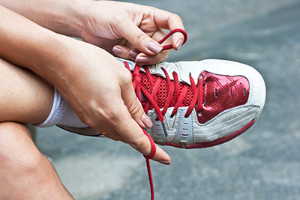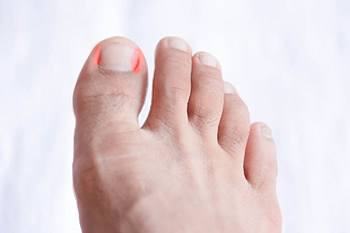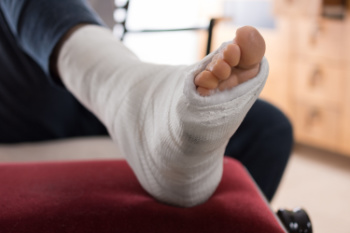Connect With Us
Blog
Items filtered by date: May 2024
The Power of Running Is Enhanced by Wearing Proper Footwear

Running offers a multitude of benefits for both physical and mental well-being. It strengthens the cardiovascular system, improves lung function, and boosts metabolism, aiding in weight management and overall health. Beyond the physical advantages, running also promotes mental clarity, stress relief, and a sense of accomplishment. However, to reap these benefits safely and effectively, investing in good running shoes is vital. Quality footwear provides essential support, cushioning, and stability, reducing the risk of injuries such as sprains, strains, and stress fractures. Proper running shoes are designed to accommodate the unique biomechanics of each individual, offering optimal shock absorption and alignment for a smoother, more comfortable stride. By selecting the right shoes for their foot type and running style, runners can enhance performance, minimize discomfort, and prolong their running journey, ensuring they can continue to enjoy the myriad benefits that running has to offer for years to come. Injuries to the foot and ankle can happen from running, and it is essential the right running shoes are chosen. It is suggested that you contact a podiatrist who can treat foot and ankle injuries, and guide you on what the best type of running shoes are right for you.
If you are a runner, wearing the right running shoe is essential. For more information, contact Zina Cappiello, DPM from Dr. Zina B. Cappiello DPM, LLC. Our podiatrist can provide the care you need to keep you pain-free and on your feet.
Choosing the Right Running Shoe for Your Foot Type
To increase performance and avoid the risk of injury, it is important to choose the right running shoe based on your foot type. The general design of running shoes revolves around pronation, which is how the ankle rolls from outside to inside when the foot strikes the ground.
- Neutral runners are able to choose from a wide variety of shoes, including minimalist shoes or even going barefoot.
- Runners who overpronate, or experience an over-abundance of ankle rolling, should choose shoes that provide extra motion control and stability.
- Runners who underpronate, or supinate, have feet that have high arches and lack flexibility, preventing shock absorption. They require shoes with more flexibility and cushion.
If you have any questions please feel free to contact our office located in Clifton, NJ . We offer the newest diagnostic and treatment technologies for all your foot and ankle needs.
How to Know if You Have an Ingrown Toenail

Recognizing an ingrown toenail early is important for timely treatment and prevention of complications. This condition occurs when the edge of a toenail grows into the surrounding skin, leading to inflammation, pain, and potential infection. Common causes of an ingrown toenail include improper nail trimming, wearing tight footwear, or genetic predisposition. Symptoms of an ingrown toenail can consist of redness, swelling, and tenderness along the nail border. In severe cases, pus or drainage may occur. Diagnosis typically involves a physical examination by a podiatrist. Treatment options include remedies like warm soaks and gentle nail trimming. A podiatrist also may offer treatment such as lifting the nail edge or surgical removal. If you have an ingrown toenail, it is suggested that you schedule an appointment with a podiatrist to prevent symptoms from worsening and obtain correct treatment.
Ingrown toenails can become painful if they are not treated properly. For more information about ingrown toenails, contact Zina Cappiello, DPM of Dr. Zina B. Cappiello DPM, LLC. Our podiatrist can provide the care you need to keep you pain-free and on your feet.
Ingrown Toenails
Ingrown toenails occur when a toenail grows sideways into the bed of the nail, causing pain, swelling, and possibly infection.
Causes
- Bacterial infections
- Improper nail cutting such as cutting it too short or not straight across
- Trauma to the toe, such as stubbing, which causes the nail to grow back irregularly
- Ill-fitting shoes that bunch the toes too close together
- Genetic predisposition
Prevention
Because ingrown toenails are not something found outside of shoe-wearing cultures, going barefoot as often as possible will decrease the likeliness of developing ingrown toenails. Wearing proper fitting shoes and using proper cutting techniques will also help decrease your risk of developing ingrown toenails.
Treatment
Ingrown toenails are a very treatable foot condition. In minor cases, soaking the affected area in salt or antibacterial soaps will not only help with the ingrown nail itself, but also help prevent any infections from occurring. In more severe cases, surgery is an option. In either case, speaking to your podiatrist about this condition will help you get a better understanding of specific treatment options that are right for you.
If you have any questions please feel free to contact our office located in Clifton, NJ . We offer the newest diagnostic and treatment technologies for all your foot and ankle needs.
Effective Foot Exercises to Strengthen the Feet

Strong feet are essential for stability, balance, and overall foot health. Incorporating targeted foot exercises into your routine can help strengthen the muscles, ligaments, and tendons in your feet while reducing the risk of injuries and improving performance in various activities. Toe scrunches are a simple yet effective exercise that involves scrunching your toes toward the sole of your foot and then spreading them out as wide as possible. Another beneficial exercise is toe raises, where you lift your toes off the ground while keeping your heels planted and then lower them back down. Additionally, practicing calf raises can strengthen the muscles in your lower legs and feet, enhancing stability and power. You can also use resistance bands to perform exercises, such as toe flexion and extension, which target specific muscles in the feet and ankles. It is important to be informed about overall foot health, and if you are seeking additional foot stretches to perform, it is suggested that you confer with a podiatrist.
Exercising your feet regularly with the proper foot wear is a great way to prevent injuries and build strength. If you have any concerns about your feet, contact Zina Cappiello, DPM from Dr. Zina B. Cappiello DPM, LLC. Our podiatrist can provide the care you need to keep you pain-free and on your feet.
Exercise for Your Feet
Exercise for your feet can help you gain strength, mobility and flexibility in your feet. They say that strengthening your feet can be just as rewarding as strengthening another part of the body. Your feet are very important, and we often forget about them in our daily tasks. But it is because of our feet that are we able to get going and do what we need to. For those of us fortunate enough to not have any foot problems, it is an important gesture to take care of them to ensure good health in the long run.
Some foot health exercises can include ankle pumps, tip-toeing, toe rises, lifting off the floor doing reps and sets, and flexing the toes. It is best to speak with Our podiatrist to determine an appropriate regimen for your needs. Everyone’s needs and bodies are different, and the activities required to maintain strength in the feet vary from individual to individual.
Once you get into a routine of doing regular exercise, you may notice a difference in your feet and how strong they may become.
If you have any questions please feel free to contact our office located in Clifton, NJ . We offer the newest diagnostic and treatment technologies for all your foot and ankle needs.
Consulting a Podiatrist for a Foot Fracture

A broken foot, or foot fracture, occurs when one or more bones in the foot are cracked or broken. This can happen due to trauma from accidents, falls, sports injuries, or from repetitive stress over time. Fractures are categorized as open, when the bone breaks through the skin, or closed, where the skin remains intact. Treatment for a broken foot depends on the location and severity of the fracture. It may involve immobilization with a cast or splint, rest, elevation, and sometimes surgery to realign the bones and facilitate proper healing. If you have broken your foot, it is suggested that you schedule an appointment with a podiatrist who can provide expert assessment, develop a tailored treatment plan, and offer ongoing care to ensure optimal recovery and long-term foot health.
A broken foot requires immediate medical attention and treatment. If you need your feet checked, contact Zina Cappiello, DPM from Dr. Zina B. Cappiello DPM, LLC. Our podiatrist can provide the care you need to keep you pain-free and on your feet.
Broken Foot Causes, Symptoms, and Treatment
A broken foot is caused by one of the bones in the foot typically breaking when bended, crushed, or stretched beyond its natural capabilities. Usually the location of the fracture indicates how the break occurred, whether it was through an object, fall, or any other type of injury.
Common Symptoms of Broken Feet:
- Bruising
- Pain
- Redness
- Swelling
- Blue in color
- Numbness
- Cold
- Misshapen
- Cuts
- Deformities
Those that suspect they have a broken foot shoot seek urgent medical attention where a medical professional could diagnose the severity.
Treatment for broken bones varies depending on the cause, severity and location. Some will require the use of splints, casts or crutches while others could even involve surgery to repair the broken bones. Personal care includes the use of ice and keeping the foot stabilized and elevated.
If you have any questions please feel free to contact our office located in Clifton, NJ . We offer the newest diagnostic and treatment technologies for all your foot and ankle needs.

